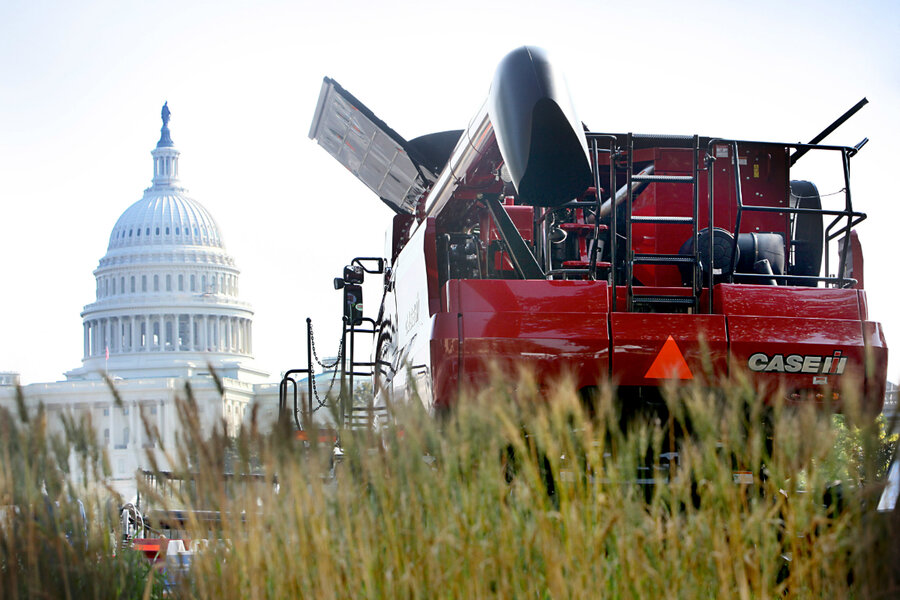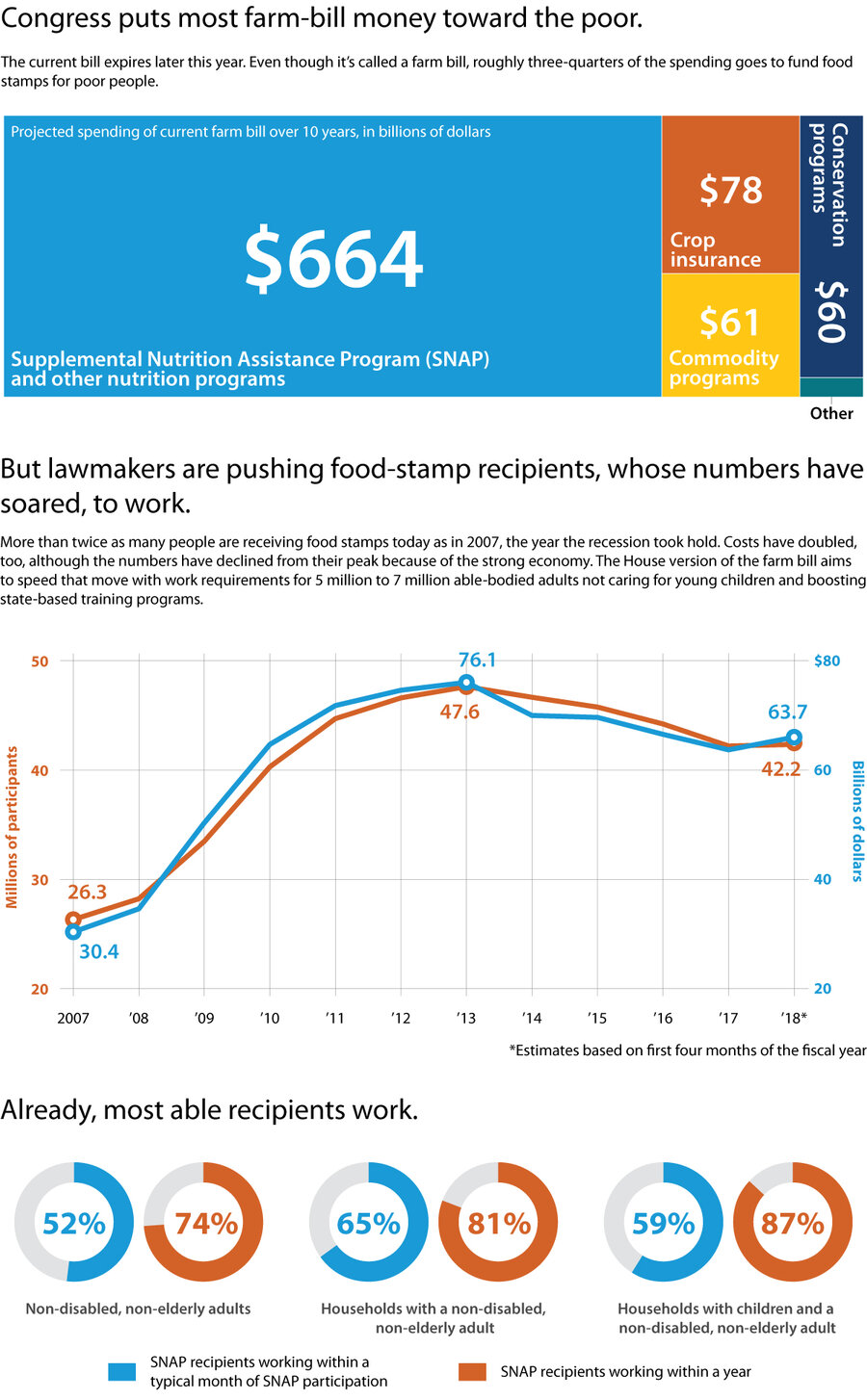US farm bill: the food stamp showdown
Loading...
The farm bill, a giant piece of legislation, has major implications for federal support of farmers, food prices, food aid for poor people, land conservation, and what kinds of food are grown in the United States, among other things.
Q: How long has the farm bill been around?
President Franklin D. Roosevelt introduced the first farm bill in 1933 as part of the New Deal. The Agricultural Adjustment Act was in response to rock-bottom food prices brought on by the Great Depression and was aimed at correcting a crop surplus. It paid farmers to stop producing so prices would go up – and set the stage for nearly a century of crop subsidies and crop insurance.
These days the farm bill expires about every four years, requiring review, debate, and proposals for updates to be passed by Congress and then signed into law by the president. Hearings on all 12 titles of the 2014 bill have been under way in US agricultural communities since 2016.
The Agricultural Act of 2014 was projected to cost about $95 billion a year, according to the Congressional Budget Office (CBO), with the biggest chunk – about $75 billion – supporting nutrition programs mainly under the Supplemental Nutrition Assistance Program (SNAP). The inclusion of food stamps under the farm bill has been seen as a crucial way to secure the votes of urban lawmakers, who might not otherwise support farm subsidies.
The 2014 farm bill is set to expire, for the most part, at the end of September.
Q: Why is the farm bill so important?
Farming is a risky business susceptible to weather, pests, climate change, and shifting global markets. Crop insurance provided by the bill – with 62 percent of premiums subsidized by taxpayers – protects farmers and, by extension, food security in the US.
“Farmers and ranchers are hurting right now, and the farm bill is an essential tool that helps weather the storm,” said Rep. Michael Conaway (R) of Texas, chairman of the House Agriculture Committee, at a California listening session this past August.
But critics of crop insurance say that instead of encouraging innovation and diversified income streams via small-scale sustainable agriculture, the law largely reinforces the status quo by favoring commodity farmers growing such crops as corn, soybeans, and cotton.
Although some reforms came in the 2014 bill, large-scale farmers have historically found it easier to apply for crop insurance because they have more streamlined records of crop yields and a track record of revenue, says Laurie Ristino, director of the Center for Agriculture and Food Systems at Vermont Law School in South Royalton. “Whereas for smaller diversified farmers, it’s more cumbersome to keep records of their different lines of revenue [with] diversified crops. It’s just much more challenging,” she says.
Q: How does it pass?
In a severely split Congress, the farm bill can provide a rare opportunity for bipartisanship if Republicans and Democrats agree on any amendments to the existing law. But the size of the bill and its complexity present a formidable hurdle, especially during a year with midterm elections and the circling threat of a trade war with China. And days in the legislative calendar are running out.
The House passed the Agriculture and Nutrition Act of 2018 out of committee on April 18. But on the House floor, the bill could be at an impasse. Republicans have proposed channeling some money from SNAP into an expansion of employment training programs for SNAP recipients, which in effect would broaden work requirements for the recipients. The changes are expected to transition 1 million people out of SNAP over the coming decade.
“We’ve got a nutrition title that really does help our neighbors in need.... It creates some on-ramps to opportunities through some workforce solutions, but it also addresses some program integrity issues,” said Rep. Glenn Thompson (R) of Pennsylvania, chairman of the Subcommittee on Nutrition, at a press conference that revealed the bill.
Democrats are strongly opposed to any cuts to SNAP.
According to the CBO the House bill, in comparison with the 2014 law, comes out to almost $90 billion less over 10 years. The House Agriculture Committee has anticipated it would need 218 votes to pass its version of the farm bill.
“I’m agnostic as to whether those are Republican or Democratic votes,” said House Agriculture Chairman Mike Conaway at a press conference. “Anybody who eats ought to be really in favor of good agricultural programs, whether you are in a big city or not.”
At press time, it was not clear when the bill would move to the floor for a vote.
Q: How does the White House play into all this?
The White House budget released in February proposed cuts to crop insurance by dropping premium subsidies to 48 percent and making the insurance available only to those producers with an adjusted gross income of $500,000 or less. Among other things, the Trump administration also wants to trim SNAP dollars by a third and tighten work requirements for SNAP recipients.
Cuts to crop insurance and SNAP are two of the most controversial topics in the 2018 farm bill.
Q: What happens if it doesn’t pass?
If Congress is unable to pass a new bill by the September deadline, the current law will probably be extended. The 2008 bill was extended to 2012, and then it took until 2014 to pass the current law. “It was the messiest farm bill cycle that I could ever remember,” says Ms. Ristino at Vermont Law School. “The traditional coalition that used to get this thing done pretty effectively is no longer strong,” she adds. “It will likely take longer to put the pieces together and wrangle it out.”









